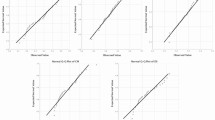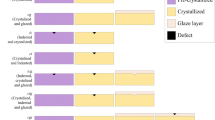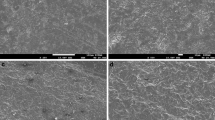Abstract
Polishing is taken up as an alternative to reglazing after adjustments of glazed ceramic prosthesis. An in vitro study was carried out to evaluate three different ceramic polishing systems and their combinations to identify a method that would achieve surface smoothness superior to the glazed surface. 77 glazed feldspathic porcelain disc surfaces, of diameter 12.5 mm and thickness 2 mm were constituted into seven groups of 11 specimen surfaces each. The glazed surfaces in the first group served as control (C). They were not subjected to deglazing or polishing. The remaining 66 surfaces underwent deglazing. The deglazed surfaces in the second group (D) were retained as such and did not undergo polishing. The deglazed surfaces in the third group (Wh), were polished using a polishing wheel (CeraMaster). In the fourth group (K), an adjustment kit (Porcelain Adjustment kit) was used for polishing the deglazed surfaces. The fifth group (Wx) was polished with diamond particle-impregnated wax (Dura-Polish Dia). In all these three groups, polishing was done for 40 s. The deglazed surfaces of the sixth group (WhWx) were polished initially with polishing wheel for 40 s and then with diamond particle-impregnated wax for 40 s. In the seventh group (KWx), the deglazed surfaces were polished with an adjustment kit (Porcelain Adjustment kit) for 40 s followed by diamond particle-impregnated wax (Dura-Polish Dia) for 40 s. In the sixth and seventh groups, the total polishing time was 80 s each. From each group, one specimen was set aside for scanning electron microscopy (SEM). The remaining ten specimens in each group underwent colorimetry and profilometry. Colorimeter (Minolta CR-200b ChromaMeter; Minolta, Osaka, Japan) was used to measure parameters according to CIE L*a*b* colour system and colour difference (ΔE) between control and other groups were calculated. Profilometer (Talysurf CLI 2000) was used to measure the surface roughness (Ra). The data were statistically analysed by one way ANOVA and Tukey HSD tests. The colour differences were well within the acceptable range of 3.3 units in groups subjected to polishing. Polishing with porcelain adjustment kit alone, diamond particle-impregnated wax alone or polishing wheel followed by diamond wax created surfaces with smoothness comparable to the glazed surfaces. The group polished by adjustment kit followed by diamond particle-impregnated wax showed surface roughness significantly less than the glazed surfaces. The SEM observations were corroboratory. It can be concluded that polishing with porcelain adjustment kit followed by diamond particle-impregnated wax, created surfaces significantly smoother than the glazed specimens with no significant negative effect on colour and thus can be a technique superior to glazing.









Similar content being viewed by others
References
Anusavice KJ, Phillips RW (eds) (2003) Phillip’s science of dental materials, 11th edn. Elsevier, St. Louis, p 660–672
O’Brien WJ (ed) (2002) Dental porcelain. Dental materials and their selection, 3rd edn. Quintessence, Chicago, p 210
Wright MD, Masri R, Driscoll CF, Romberg E, Thompson GA, Runyan DA (2004) Comparison of three systems for the polishing of an ultra-low fusing dental porcelain. J Prosthet Dent 92:486–490
al-Wahadni A, Martin DM (1998) Glazing and finishing dental porcelain: a literature review. J Can Dent Assoc 64:580–583
Quirynen M, Bollen CM (1995) The influence of surface roughness and surface free energy on supra- and subgingival plaque formation in man. A review of literature. J Clin Periodontol 22:1–14
Quirynen M, Marechal M, Busscher HJ, Weerkamp AH, Darius PL, van Steenberghe D (1990) The influence of surface free energy and surface roughness on early plaque formation. An in vivo study in man. J Clin Periodontol 17:138–144
Kawai K, Urano M, Ebisu S (2000) Effect of surface roughness of porcelain on adhesion of bacteria and their synthesizing glucans. J Prosthet Dent 83:664–667
Clayton JA, Green E (1970) Roughness of pontic materials and dental plaque. J Prosthet Dent 23:407–411
Schlissel ER, Newitter DA, Renner RR, Gwinnett AJ (1980) An evaluation of postadjustment polishing techniques for porcelain denture teeth. J Prosthet Dent 43:258–265
Jagger DC, Harrison A (1994) An in vitro investigation into the wear effects of unglazed, glazed, and polished porcelain on human enamel. J Prosthet Dent 72:320–323
Al-Hiyasat AS, Saunders WP, Sharkey SW, Smith G, Gilmour WH (1997) The abrasive effect of glazed, unglazed and polished porcelain on the wear of human enamel, and the influence of carbonated drinks on the rate of wear. Int J Prosthodont 10:269–282
Bessing C, Wiktorsson A (1983) Comparison of two different methods of polishing porcelain. Scand J Dent Res 91:482–487
Giordano RA 2nd, Campbell S, Pober R (1994) Flexural strength of feldpathic porcelain treated by ion exchange, overglaze and polishing. J Prosthet Dent 71:468–472
Giordano R, Cima M, Pober R (1995) Effect of surface finish on the flexural strength of feldspathic and aluminous dental ceramics. Int J Prosthodont 8:311–319
Brewer JD, Garlapo DA, Chipps EA, Tedesco LA (1990) Clinical discrimination between autoglazed and polished porcelain surfaces. J Prosthet Dent 64:631–635
Sulik WD, Plekavich EJ (1981) Surface finishing of dental porcelain. J Prosthet Dent 46:217–221
Haywood VB, Heymann HO, Kusy RP, Whitley JQ, Andreaus SB (1988) Polishing porcelain veneers: an SEM and specular reflectance analysis. Dent Mater 4:116–121
Scurria MS, Powers JM (1994) Surface roughness of two polished ceramic materials. J Prosthet Dent 71:174–177
Klausner LH, Cartwright CB, Charbeneau GT (1982) Polished versus autoglazed porcelain surfaces. J Prosthet Dent 47:157–162
Raimondo RL Jr, Richardson JT, Wiedner B (1990) Polished versus autoglazed dental porcelain. J Prosthet Dent 64:553–557
Goldstein RE (1989) Finishing of composites and laminates. Dent Clin North Am 33:305–318
Patterson CJ, McLundie AC, Stirrups DR, Taylor WG (1991) Refinishing of porcelain by using a refinishing kit. J Prosthet Dent 65:383–388
Sarac D, Sarac YS, Yuzbasioglu E, Bal S (2006) The effects of porcelain polishing systems on the color and surface texture of feldspathic porcelain. J Prosthet Dent 96:122–128
Saraç D, Turk T, Elekdag-Turk S, Saraç YS (2007) Comparison of 3 polishing techniques for 2 all-ceramic materials. Int J Prosthodont 20:465–468
Seghi RR, Johnston WM, O’Brien WJ (1986) Spectrophotometric analysis of color differences between porcelain systems. J Prosthet Dent 56:35–40
Ruyter IE, Nilner K, Moller B (1987) Color stability of dental composite resin materials for crown and bridge veneers. Dent Mater 3:246–251
Inokoshi S, Burrow MF, Kataumi M, Yamada T, Takatsu T (1996) Opacity and color changes of tooth-colored restorative materials. Oper Dent 21:73–80
Kim HS, Um CM (1996) Color differences between resin composites and shade guides. Quintessence Int 27:559–567
Koishi Y, Tanoue N, Matsumura H, Atsuta M (2001) Color reproducibility of a photo-activated prosthetic composite with different thicknesses. J Oral Rehabil 28:799–804
Stober T, Gilde H, Lenz P (2001) Color stability of highly filled composite resin materials for facings. Dent Mater 17:87–94
Yap AU (1998) Color attributes and accuracy of Vita-based manufacturers’ shade guides. Oper Dent 23:266–271
Conflict of interest
None.
Author information
Authors and Affiliations
Corresponding author
Electronic Supplementary Material
Rights and permissions
About this article
Cite this article
Manjuran, N.G., Sreelal, T. An In Vitro Study to Identify a Ceramic Polishing Protocol Effecting Smoothness Superior to Glazed Surface. J Indian Prosthodont Soc 14, 219–227 (2014). https://doi.org/10.1007/s13191-013-0313-3
Received:
Accepted:
Published:
Issue Date:
DOI: https://doi.org/10.1007/s13191-013-0313-3





